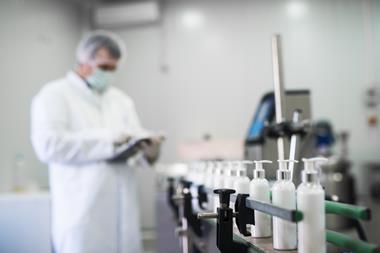Skin care is a huge global industry, but how many of the claims made in the adverts are really true? Laura Howes investigates how chemistry is trying to roll back the years – or at least the appearance of them
The shiny vials and pots that seem to whisper promises of eternal youth as you browse are about as close as modern science gets to alchemy and magic. But beyond the promises and the packaging, the world of skincare and anti-ageing are starting to deliver clinically proven results.
Back in 2007, Chris Griffiths’ group at the University of Manchester, UK, caused an incredible reaction with the news that a certain skin cream was actually effective at causing changes in the skin of people who used it. When the news broke, via a BBC Horizon programme, queues of mostly female shoppers camped outside branches of Boots across the country to get their hands on the miracle cream that seemed to be backed up with science.
For many years, consumers have had little real evidence on which to base their purchases; small sample sizes of women giving their subjective opinions, reported by the very companies promoting their products, meant that products were often dismissed as ineffectual. And yet the cosmetics industry has continued to grow. Was Griffiths’ experimentation a new beginning for the skincare industry, with real evidence to back up the marketing departments’ claims?
The magic ingredient
‘Wrinkles are due to a loss of what we call the extracellular matrix,’ explains Griffiths. ‘This supplies skin with its tensile strength and elasticity.’ Sunlight, specifically UVA, and environmental factors, such as cigarette smoke, break down both the collagen and the elastic tissue around it and that is thought to cause wrinkling. ‘That’s our working hypothesis,’ says Griffiths, ‘and there is a rough clinical correlation between loss of collagen and fibrillin and severity of wrinkling.’

In the Boots product that Griffiths tested, the active ingredient was pro-retinol – a form of vitamin A. Topical retinoids were first used to treat acne, before it was noticed that female patients were coming back, claiming the treatments also improved their wrinkles.1 In the 1980s, dermatologist Albert Kligman, showing what Griffiths describes as a ‘healthy dose of scepticism’, reported this result, and the world of dermatology is still discovering how retinoids improve aging skin. What is agreed is that retinoids stimulate fibroblasts in the skin to produce more collagen and fibrillin, the proteins that make up the extracellular matrix that holds up our skin in its youthful, plump form.
So you might not expect the news that a retinol-containing skin cream gave an improvement to be so headline-grabbing , but that the cream was available on the high street surprised everyone.
In his work with Boots, Griffiths’ team developed an assay that tested biopsies of skin exposed to the product showed a restoration of the fibrillin fibrils that act like ‘tent pegs’ and fix the skin to the extracellular matrix. ‘That was a surprise to us because previously we’d only seen that in a medicinal product.’ A further randomised controlled trial, more usually the preserve of the pharmaceutical industry, showed that the No7 Protect and Perfect serum did improve wrinkles clinically.2 ‘As a consequence of that study the whole landscape of cosmetic over the counter marketing has changed,’ adds Griffiths. ‘you’ll see L’Oréal, Procter and Gamble, and others using placebo controlled trials.’ But have the products always worked?
From clinic to high street
Most of the active ingredients in various anti-ageing treatments were first used in clinical dermatological settings, be that retinoids for acne, skin tone issues and anti-wrinkle properties, or the addition of acids to remove older skin on the surface. Antioxidants, such as vitamins C and E, have also been shown to reduce wrinkles and pigmentation as well as protecting against UV damage.
‘I’ve been working in cosmetics since 1995 and in the first 10 years I saw a real improvement in the quality of formulas,’ says Chris Smith of formulation developers Chrysalis Health & Beauty in Nottingham, UK. ‘Instead of containing a little pipette’s worth of vitamin C just to say it’s in there, there were moves to get a lot more active [ingredients] in there to do what it says on the tin.’
The world of dermatology is still discovering how retinoids improving ageing skin
While the concentrations of active ingredients in high street formulations may have increased, they’re often still lower than those found in the clinic, and there are two main reasons for this, beyond cost. At higher doses, akin to medicines, side effects such as redness and skin irritation can start, which is not going to help sales. And at doses equivalent to medicine, skin creams can move from being treated as cosmetics to drugs, with an associated increase in the amount of legislation.
In the UK and Europe a cosmetic is defined as ‘any substance or preparation intended to be placed in contact with the various external parts of the human body with a view exclusively or mainly to cleaning them, perfuming them, changing their appearance, correcting body odours, protecting them, or keeping them in good condition.’ However, if a product contains a pharmacologically active substance, or makes medical claims, then it becomes classed as a medicine. For example, toothpaste is classed as a cosmetic, but if it claims to treat sensitive teeth, it becomes defined as a medicine.
Across the Atlantic things are different again, explains David McDaniel, a cosmetic dermatologist based in Virginia, US. ‘In America, the FDA [Food & Drug Administration] regulates products which “alter the structure and/or function of the skin”… and the CTFA [Cosmetic, Toiletry, and Fragrance Association] regulates marketing of things which improve the appearance of the skin.’ McDaniel continues: ‘Thus, a drug-like effect which is marketed to “reduce the appearance” of wrinkles is typically viewed differently, regulatory wise, in the US than the same active ingredient which is marketed as “reduces wrinkles and produces new collagen”.’
And so there is a fine balancing act between producing a product that contains enough active ingredient, but not too much, and marketing it to persuade customers the product works, without being so bold as to catch the eye of stricter regulation. This straddling between two regulatory worlds has resulted in the term cosmeceutical, which although catchy does not have a strict definition.
Surprising lack of science
However, it is not just the amount of the active ingredient that ensures efficacy; formulations have to keep the active ingredients stable until the product is used, and then help them pass through the skin barrier to where they can get to work. While formulations today can be full of chemical tricks to improve the feel and the efficacy of the product, in some ways the science is not as advanced as you might think. ‘Does anyone really know what is happening to the composition, structure, and concentration, much less the transport into the skin? I think there is, for the most part, very little known,’ says McDaniel.
Smith agrees: ‘It’s a huge area of debate, because realistically the vast majority of cosmetics don’t penetrate more than 10 or 15 layers [of the skin], so a lot of the claims are based on tests that are done in vivo. But actually putting the cream on the skin, you’re not getting that effect on the epidermis.’ At the higher end of the market, he says, they do try to focus on trying to deliver the cream and active ingredients as far down into the skin as they can ‘but in all honesty we never really know whether we’ve achieved it’.
The vast majority of tests they perform never determine if the active ingredients are delivered to where they are needed, but instead examine whether the formulation is having the desired effect. ‘And if we know something needs to penetrate deeply to work,’ he explains, ‘we do use certain tricks to get it in there.’
So how do formulation chemists deliver active ingredients deep into the skin when it is such a good barrier and, with so many potent active ingredients and antioxidants now being added to formulations, how do they avoid these ingredients reacting with each other before the cream ever sees a face?
A lot of the claims are based on in vivo tests, but you’re not getting that effect on the epidermis
Most moisturisers on the market today, says Smith, are oil in water emulsions and the vast majority of those rely purely on diffusion to deliver any active ingredients. To improve penetration in these cases, formulators can use tricks first learnt from the pharmaceutical sector: for example, replacing glycerine with one of several glycols is known to aid penetration. But the preferred method to solve both the problem of delivery and that of preventing interactions between ingredients, according to Smith, is to use liposomes and multiphase systems such as oil–water–oil colloidal systems to compartmentalise different ingredients. Enclosing an aqueous phase inside phospholipid capsules, or liposomes, helps the aqueous phase pass through the stratum corneum, the layers of dead skin cells on the surface, and penetrate deeper into the skin.
Smith says he saw an improvement in formulation from 1995 to 2005, but in the last few years he has seen formulations change less to improve the delivery and active ingredients and more to address various marketing concerns. The first change, Smith says, came with the removal of mineral oil, which was in the vast majority of skincare, because it clogged the pores. Then, he says, came the addition of silicones and high molecular weight silicone elastomers that give serums their silky feel, but are a purely cosmetic ingredient that washes off. ‘It completely changed the market,’ Smith adds, ‘because this silky feel without being oily or greasy was really desirable. But for me, looking for cosmetics to actually perform, it was another sideways step.’ And now silicones are getting a bad press, the cycle continues.
The strength of marketing
It should come as no surprise that the marketing departments are so important to an industry worth around $2 billion annually. They are one of the most visible parts of the skincare industry and how most consumers know anything about what is in the products or what they claim to achieve. On the high street, claims Theresa Callaghan of Callaghan Consulting International, Germany, marketers often ‘develop claims in order to be able to sell the product,’ and unfortunately the testing to verify those claims comes later in the R&D stage.
Callaghan, who previously worked in R&D in the cosmetics industry, is a vocal critic of what she sees as the disconnect between the marketers and the research and development side. While the formulation chemists can buy active ingredients that have been shown to work, the budget for testing the effectiveness of new products is often under the R&D side of the business but, as Callaghan points out, marketing is also a stakeholder. Supporting the marketing claims, she says, can sometimes be an ‘afterthought’.

‘You’ve got a group of people,’ Callaghan says, ‘that have their own agendas and you need to bring them together to get the common knowledge to decide, for example, that this active ingredient in vitro has an effect on autophagy. When it comes to talking to the consumer, I can tell a nice story but how do I prove it?’ The problem, Callaghan adds, is that marketing departments may well decide the story they want to tell based on the active ingredients used, and then design clinical trials to back them up. This can result in claims that bear no relation to those made by the suppliers of the active ingredients.
And Callaghan is very clear about what she thinks should happen, with R&D and marketing sharing the cost of running clinical studies, allowing both sides to remain clear about what is being studied and why. ‘All Chris Griffiths did was do a clinical study versus a placebo; this is what everyone should be doing,’ she adds. ‘The consumer wants a product that performs.’
A new era?
Back in 2007 there was speculation that Griffiths’ findings could signal the beginning of a new, more accountable era of cosmeceuticals, with real clinical results to back up the claims made about each product. And in some ways that has happened. Griffiths’ assay is now used by many manufacturers who are using the latest science to improve the formulation in of their products.
The consumer wants a product that performs
New active ingredients are also being found and developed, from new antioxidants to new compounds to prevent the glycosylation of proteins and lipids in the skin. And while McDaniel and Griffiths both agree there is a lot more to be done with antioxidants and the retinoid family of compounds, McDaniel tips anti-glycosylation agents and plant stem cells as the next active ingredients to start cropping up on our bathroom shelves.
But while the industry is becoming perhaps more scientific, there are still many open questions about how and why certain products work at the molecular level and it is unlikely those questions will get answered soon. Ultimately, while changes to formulations may be made for reasons other than efficacy, in today’s marketplace cosmeceuticals have to be shown to be effective to compete, and that is sure to drive new science.
And you can listen to an interview with Chris Griffiths in the October Chemistry World podcast.
References
1 O H Mills and A M Kligman, Semin. Dermatol., 1982, 1, 233
2 R E B Watson et al, Brit. J. Dermatol., 2009, 161, 419 (DOI: 10.1111/j.1365-2133.2009.09216.x)













No comments yet